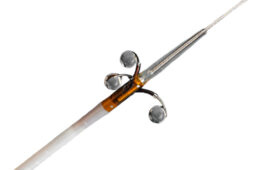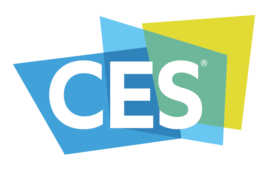
The therapeutic cancer vaccine employs nanodiscs (in blue) loaded with tumor neoantigens, which are unique mutations from the patient’s own tumor cells. By generating T-cells to recognize the neoantigens, the nanodiscs can target a patient’s cancer mutations and fight to eliminate cancer cells and prevent tumor growth. [Photo courtesy James Moon, John Gideon Searle]
Nanodiscs loaded with tumor neoantigens deliver a customized therapeutic vaccine targeting cancer mutations. The neoantigens are unique mutations found in tumor cells, and the technology of the nanodiscs recognizes the neoantigens and creates T-cells to fight and eliminate tumors.
“We are basically educating the immune system with these nanodiscs so that immune cells can attack cancer cells in a personalized manner,” said James Moon, assistant professor of pharmaceutical sciences and biomedical engineering at the University of Michigan.
Moon and his team created the nanodiscs out of small, synthetic, high-density lipoproteins that are about 10 nanometers wide (human hair measures 80,000 to 100,000 nm wide). These therapeutic cancer vaccines are made to kill existing cancer cells.
“The idea is that these vaccine nanodiscs will trigger the immune system to fight the existing cancer cells in a personalized manner,” Moon said.
Michigan researchers tested the nanodisc technology on mice with melanoma and colon cancer, and 27% of the T-cells in the mice blood targeted the tumors. The technology killed tumors within 10 days of being vaccinated in most of the mice, and after 70 days, the immune systems of the mice rejected injected tumor cells, preventing the growth of any new tumors.
Radiation and chemotherapy cancer treatments usually affect the entire body instead of a localized tumor and have a lot of serious side effects. This nanoparticle immunotherapy is fast-growing in the fight against cancer.
“The holy grail in cancer immunotherapy is to eradicate tumors and prevent future recurrence without systemic toxicity, and our studies have produced very promising results in mice,” Moon said.
The Michigan study is not the first time researchers have been able to kill cancer cells with injectable nanoparticle-generating technology. In 2016, researchers were able to successfully inject the chemotherapy drug doxorubicin straight to the nucleus of metastatic breast cancer cells in mice using an injectable nanoparticle generator (iNPG). Nanoparticles containing the chemotherapy drugs are released from the nanopores of the iNPG once the iNPG reaches the tumor vasculature. This technology was made to increase drug potency and reduce the development of drug resistance in cancer cells.
The nanodisc study was published online in the publication Nature Materials.
[Want to stay more on top of MDO content? Subscribe to our weekly e-newsletter.]




